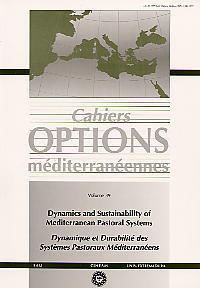| p. 13-27 | Article suivant |
Agroecologic characterization and assessment of the agricultural production in the extensive areas of Extremadura
Edafoclimatic, socioeconomic and strategic factors have favoured the existence of vast areas of extensive agricultural production in Extremadura. Of the total regional agricultural economy, this represents 47 per cent of the (PTAE) (Total estimated agricultural production) and they also classify one of the most peculiar ecosystems in the Mediterranean area, the 'dehesa', in which the animal output, mainly autochthonous breeds of slaughter livestock ('Iberico' pig; 'Retinta', 'Avileña' and 'Morucha' cattle; 'Merina' sheep and 'Serrana' goats) exceeds both, crops and wood production (timber, cork, firewood). Other forest yields such as pastures and acorns, although economically important, are not included in the annual turnover of the agricultural sector since they are re-employed as feedingstuff for livestock. The productive ecosystem 'dehesa arbolada' presents the highest average productivity (over 40,000 Pts per ha) against the 16,000 pts per ha of both the 'marginal dehesa' and grazing land and the 6,000 pts per ha of timber forest.
- [ Afficher ]
- [ Télécharger ]
- [ Exporter la citation ]
Vous pouvez télécharger la citation au format :
- [ Imprimer ]
-
Mots-clés
AGRICULTURE EXTENSIVE, CLASSIFICATION, CLIMATOLOGIE, ESPAGNECiter cet article
Coleto Martínez J.M. Agroecologic characterization and assessment of the agricultural production in the extensive areas of Extremadura. In : Etienne M. (ed.). Dynamics and sustainability of Mediterranean pastoral systems . Zaragoza : CIHEAM, 1999. p. 13-27. (Cahiers Options Méditerranéennes; n. 39). 9. Meeting of the Mediterranean Sub-Network of the FAO-CIHEAM Inter-Regional Cooperative Research and Development Network on Pastures and Fodder Crops, 1997/11/26-29, Badajoz (Spain). http://om.ciheam.org/om/pdf/c39/99600040.pdf



